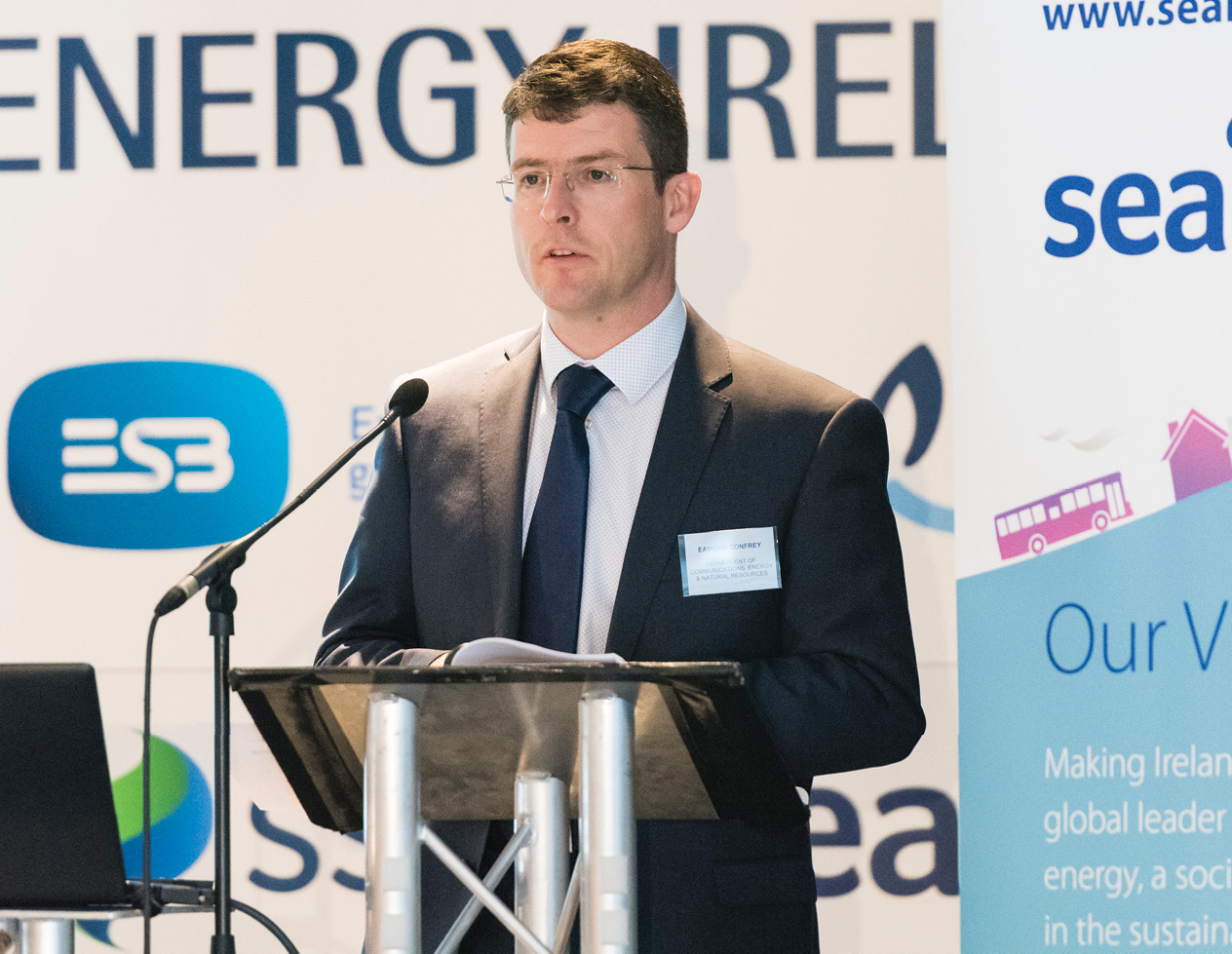
The significance of Ireland’s Renewable Heat Incentive
8th November 2016
Heating up a renewable revolution
9th November 2016Innovations in the power sector: POC-MAST, Protean and UAV LiDAR
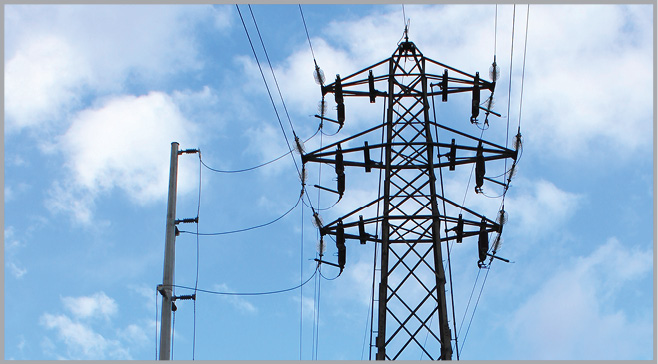

British Power International outlines the benefits of utilising their latest innovations for new connections and overhead lines.
British Power International (BPI) is a NERS Accredited Design consultancy offering a complete 11kV to 400kV design service for substations, renewables and overhead lines. BPI has a very experienced connections department which has in the last 12 months alone designed more than 60 connections for a variety of customers on a wide range of schemes. With our experience in the connections market, customers kept asking us why they couldn’t simply connect directly to the overhead line already on their land or within close proximity. With this in mind, BPI innovated to develop a safe economical system to be able to do just that – the POC-MAST. Following on from this innovation BPI also developed the Protean system – a steel pole overhead line (OHL) that can be used both to replace wood pole lines or for completely new OHL schemes.
Point of connection using the POC-MAST
The traditional methods for making a grid connection are to run a cable to the closest grid substation or connect to an overhead line structure. Connecting to an overhead line, however, is neither simple nor quick, typically requiring the replacement or extensive modification of the existing towers in order to accommodate the grid connection. For a 132kV connection this work can take over a year, involve complex consent agreements with landowners, local authorities and network operators, resulting in significant costs. The traditional options are both time consuming, expensive and involve hazardous working.
The POC-MAST can be installed and connection achieved by a four-man team within just three days. The final connection itself requires just a four hour circuit outage, thus providing considerable time and financial savings. Connection to an existing overhead line can be made in the form of a simple Tap-in or a Loop-in/ Loop-out arrangement. This can be based on a single or double circuit arrangement depending on the generator or DNO requirements. The POC-MAST is positioned adjacent to the existing overhead line tower typically 5–10m away from the cross arm end. This ensures that there is no surcharge from the POC-MAST on to the existing tower foundations, and has also been proven to give the required cross lead tensions to achieve electrical clearance whilst placing virtually no additional load on the tower. The exact distance from the tower is determined at the detailed design stage.
In 2015 the POC-MAST won a Construction News Specialist Award for “Business Innovation of the Year”.
The Protean system
The Protean system evolved from the POC-MAST technology to become the adaptable, flexible system for the replacement of overhead lines at 11, 33 and 132kV. Made from folded steel, the pole is typically a 12-sided cylinder, and for a 20m pole it would consist of multiple sections for ease of transportation and installation. It can be used for both new OHL schemes and upgrades to existing overhead lines. Additionally one off applications are also possible where, due to consents restrictions, longer span lengths or angle poles without stays are required.
The Protean system is designed to be maintenance-free for 50 years. It employs polymeric insulators which are much lighter and designed to the latest European standards. The production facility can produce 500 poles per month – designed, manufactured, galvanised and ready to go. The Protean system is in the market and available: we are currently using the Protean steel poles to replace two wood poles at a railway crossing that are over 23m high and have suffered severe damage.
The Protean design philosophy is based on using the latest overhead line design software and specialist structural analysis of the poles. The foundation design utilises a proprietary screw–anchor system requiring no excavation, and where necessary eliminates the requirement for supporting stays at angle and terminal poles.
POC-MAST and Protean installation
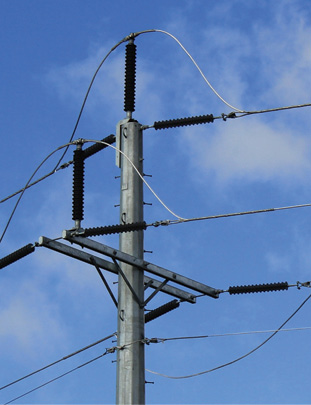
The Protean system.
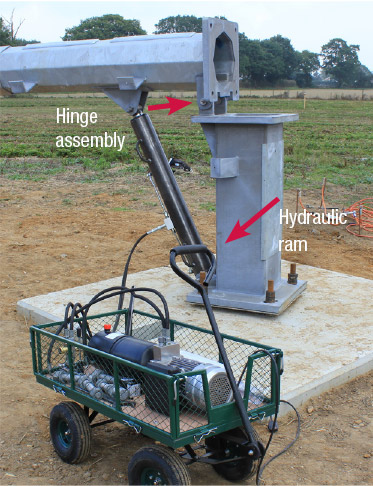
POC-MAST and Protean assembly.
BPI developed both the POC-MAST and Protean systems with speed of installation and health and safety in mind. The modular systems comprise multiple polygonal sections of folded sheet steel that are connected together at ground level to achieve the desired height. The base flange and hinge arrangement is connected to the foundation by holding down bolts. Both the POC-MAST and Protean can be fully constructed at ground level, including the insulators and other equipment, so minimal working at height. Using a hydraulic ram the mast or poles are then lifted into place within 30 seconds. Once raised, a MEWP is used to connect the cross leads (POC-MAST) or bind in the conductors (Protean).
In summary the POC-MAST minimises working at height making it intrinsically safer, reducing construction costs, reducing the time to deliver a connection project, and more importantly increasing the number of potential connections to the grid. The Protean system provides the client with the ability to customise the OHL design at the concept stage in terms of number of circuits, conductor size and operating temperature, the requirement for a conductor shield and communications, together with the basic span and maximum structure height.
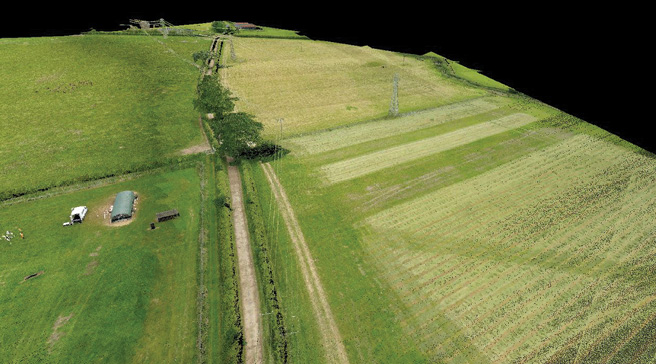
Laser point cloud data encoded by true colour.
Aerial survey using UAV and helicopters
Another key development for BPI is the company’s work with Unmanned Aerial Vehicles (UAVs). BPI has been working with a company for the last eight months to develop a UAV specifically for the LiDAR survey of OHLs and substations. Having already flown with full size helicopters using LiDAR, BPI has completed the survey of over 1,000km of overhead lines for several UK based DNOs over the past two years. Special permission has recently been granted by the CAA to trial a UAV of over 20kg, thus giving the payload required to carry the LiDAR scanner and digital imagery sensors.
With the permission of a UK DNO, the system was trialled on an 11kV OHL previously flown with helicopter LiDAR, enabling a direct comparison. The low altitude and reduced speed of the UAV resulted in a higher point cloud density and increased image resolution. The UAV LiDAR survey capability is now available and BPI is looking to utilise it for new and existing OHL surveys, OHL uprating studies and detailed tree canopy survey and clearance checking.
Other recent developments are the use of smaller UAVs for asset inspection of lattice towers. Traditional methods would have involved someone using binoculars from the ground or simply climbing the whole tower. Full-sized helicopters have been used but are expensive and noisy. With the UAV we can get right up close. Using HD cameras you can live stream, and we are also working on a hyperspectral camera that can automatically identify the level of rust. The process will then be industrialised, enabling us to have several UAVs running in both the UK and Ireland.
Email: claire.briody@bpienergy.com Website: www.bpienergy.com Author details: Bob Ford, Managing Director Address: British Power International, 7 Phoenix Square, Wyncolls Road, Colchester, Essex, CO4 9AS. Tel: 0845 168 6040 or 0845 168 6170 for Sales.

